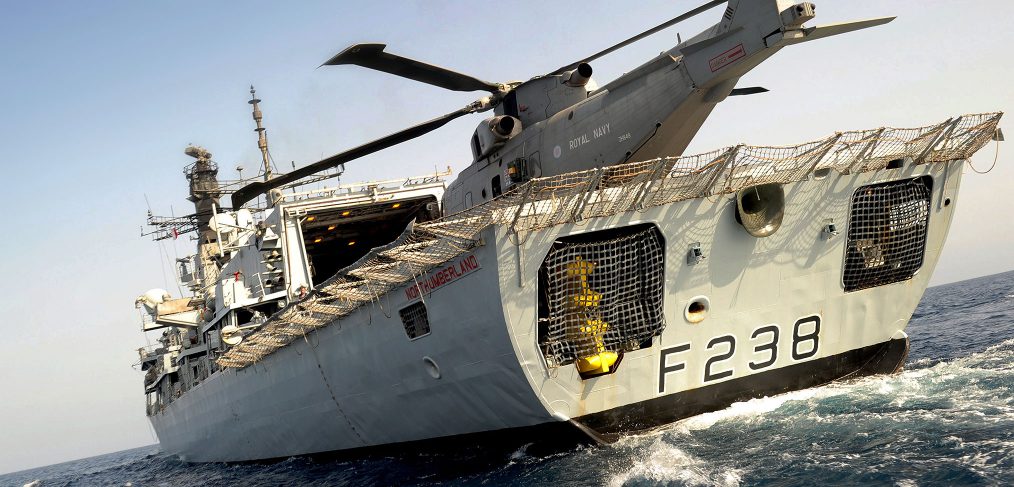
This article was first published on the Save the Royal Navy website on Oct 3rd.
The RN is unlikely to see an increase in its major anti-submarine platforms in the near future. Recognising the danger posed by the continually evolving underwater threat, it has launched ASW Spearhead, an initiative to maximise the effectiveness of the assets its already has. There will be some new hardware, in the form of new sonars but much of the focus is on improving software, building sensor networks and giving the operators new decision-making tools.
The attack submarine remains the greatest single danger to naval operations, not only to the seaborne trade the UK economy depends upon but the nuclear deterrent, the carrier strike group and amphibious forces. The RN has experienced personnel recognised as world leaders in ASW and has some very high-quality submarine-hunting platforms. Unfortunately, numbers are wholly inadequate and disproportionately small in comparison with the underwater threat posed to the UK. Finances and industrial capacity restraints mean the UK ASW ORBAT will essentially consist of; 7 Trafalgar/Astute submarines, 8 Type 23/26 frigates, 30 Merlin Mk2 helicopters (of which at least 6 are needed for Crowsnest ASaC duties) and 9 Poseidon MRA Mk1 Maritime Patrol Aircraft. Any measures that can increase the potency and reach of these scarce assets must be welcomed.ASW Spearhead is part of a broader effort by the RN to take advantage of rapidly evolving new computing and communications technologies which are relatively low cost but can deliver substantial gains. This also presents a great opportunity for academia and new high technology suppliers to engage with the navy to deliver niche capabilities. ASW Spearhead consists of 6 main projects which are outlined below.
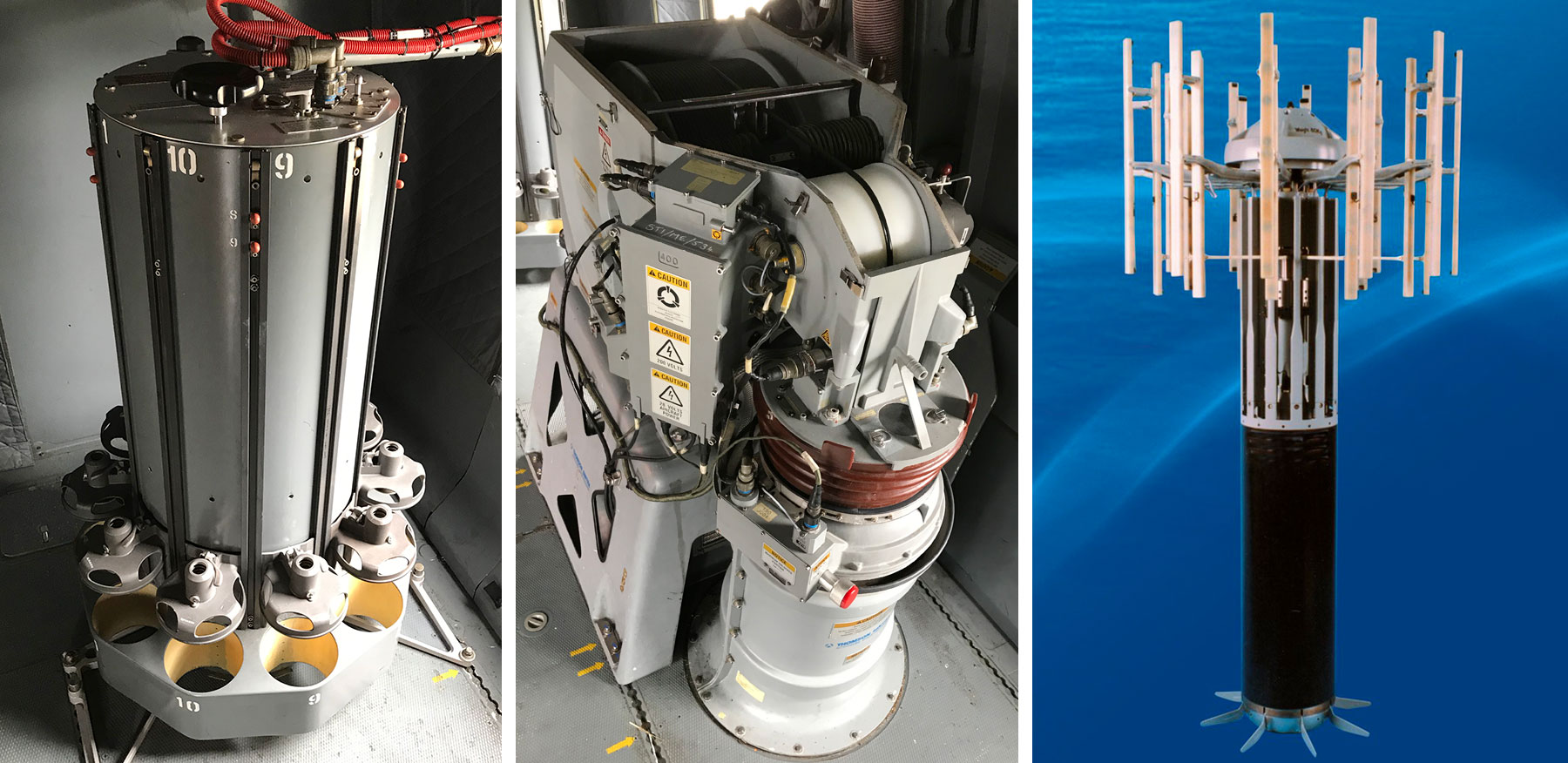
Inside the Merlin Mk2 seen at DSEI 2019. (Left) one of the two 10-cell sonobuoy dispensers. A further 10 sonobuoy reloads can be carried in a removable rack giving a total of up to 30 carried onboard. (Centre) Dipping sonar Winch. (Right) Thales FLASH active dipping sonar.
Merlin helicopter Multi Static Active sonar capability
Multi-static sonar uses a combination of sensors which may be either active or passive, operating from different locations. This could include a combination of sonobuoys, warships, UUVs or seabed arrays. The upgrade to the Merlin will integrate a Multi Static Active (MSA) system within the existing acoustic processor carried by the helicopter. The on-board processing capability will be able to manage data received from an increased number of sonobuoys. This will allow much greater co-operation with surface and subsurface assets to improve the search area and probability of detection. Not only are there more sensors in the water, but multi-static sonar operations have the advantage of triangulating the target position and allows some of the assets to remain passive and covert. For example, the Merlin transmitting on its active dipping sonar may allow passive detection of the target by a frigate operating many miles away, or when working independently using a dispersed field of sonobuoys previously laid by the aircraft.
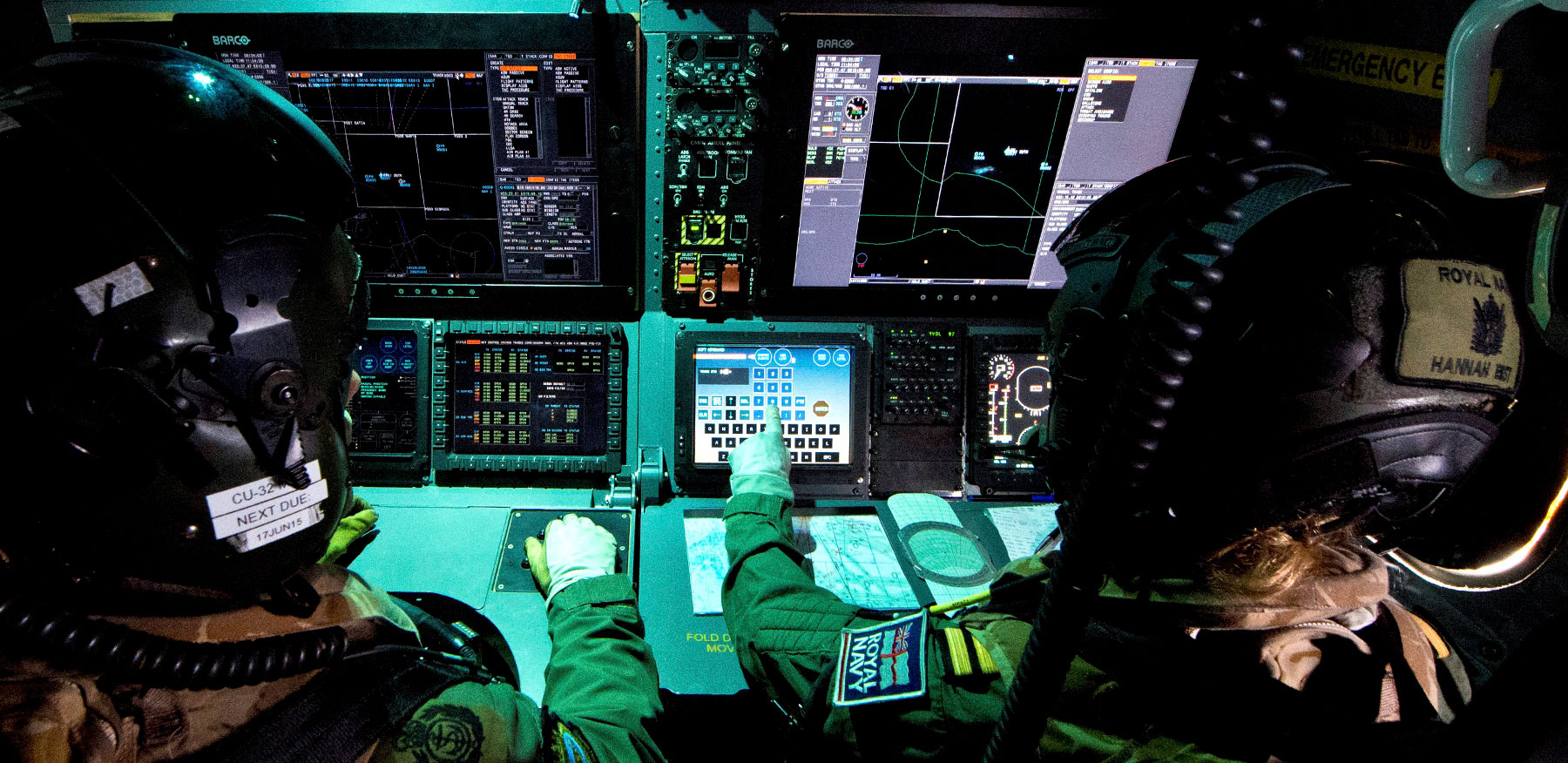
The heart of the ‘flying frigate’, Merlin Mk2 observer consoles. The planned enhancements to Merlin ASW capability will primarily be to the software, processors and consoles over a 4-year project starting in 2019. The first trials will begin within 18 months and using an agile approach to development, will see incremental improvements involving flight trials, and feedback to DSTL and industry.
2087 Sonar upgrade
The Thales 2087 sonar is the RN’s primary surface ship ASW sensor consisting of separate towed active and passive arrays. It is fitted to eight of the Type 23 frigates and will be migrated to the Type 26. Entering service in 2004, has gained a formidable reputation and underwent a technical refresh in 2017. The RN is also looking to add Novus technology to 2087 – a suite of passive sonar algorithms and Human-Computer Interface (HCI) features developed for the Sonar 2076 fitted to its submarines. Both 2076 and 2087 use common open architecture and have great potential to be improved by software and processor upgrades. Under ASW Spearhead the intention is to have a rapid capability insertion programme that leverages knowledge from industry, Programme Nelson and NavyX. (Programme Nelson is the RN’s innovation initiative focused on Artificial Intelligence and Data Science. NavyX aims to test and trial new technology for rapid delivery onto the front line).The 2087 project will be run over 7 years and aims to improve its networking capability, range and detection through better processing using AI and other non-traditional aids. Operators will be assisted by a better HCI and command decision making helped by maximising the exchange of data and new training tools.
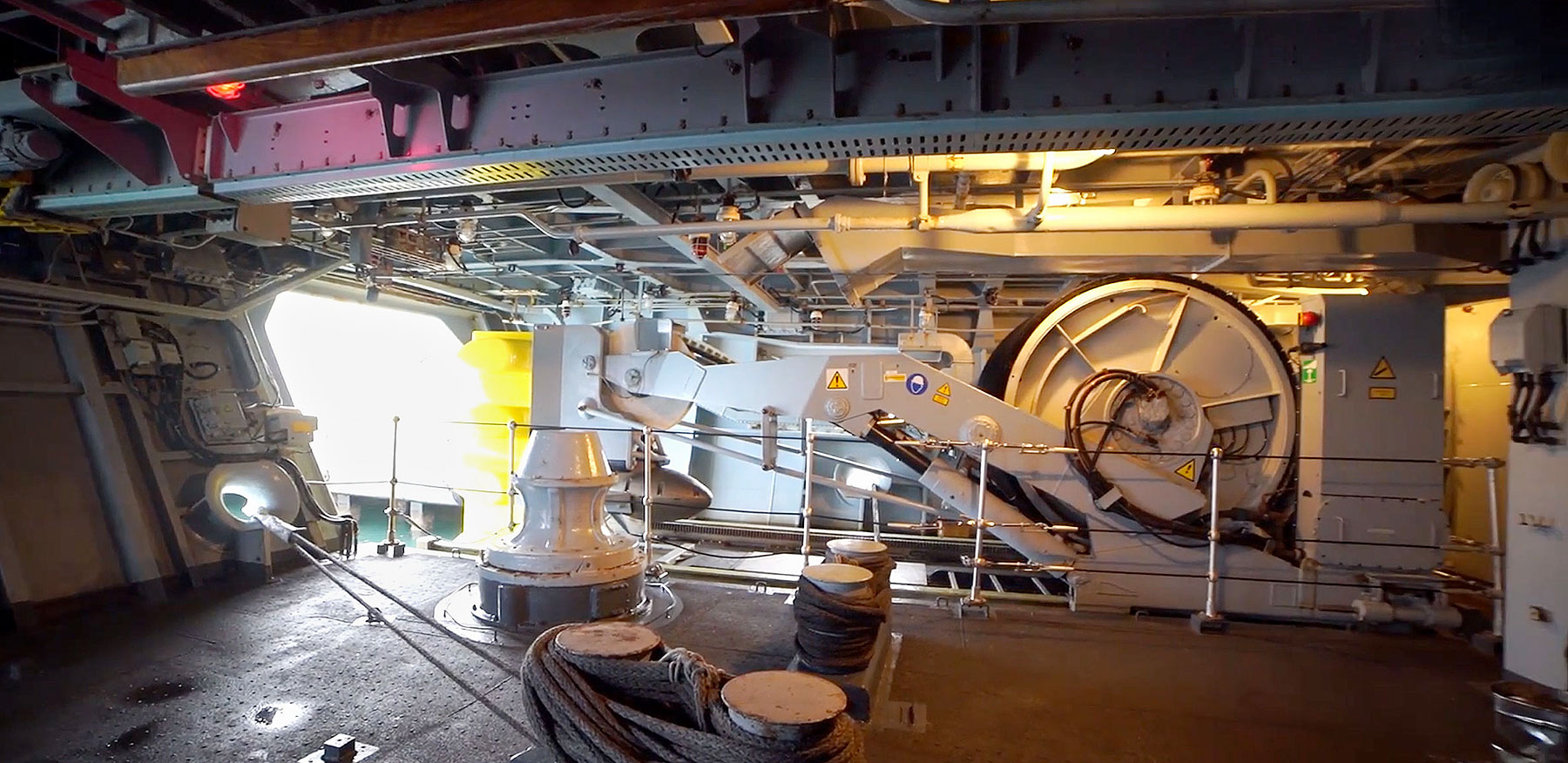
HMS Westminster’s quarterdeck showing the winch, handling system and variable depth low-frequency active body of the 2087 Sonar. In the age of the ultra-quiet submarine, active sonar has become very much more important than it was in the mid-late Cold War period.
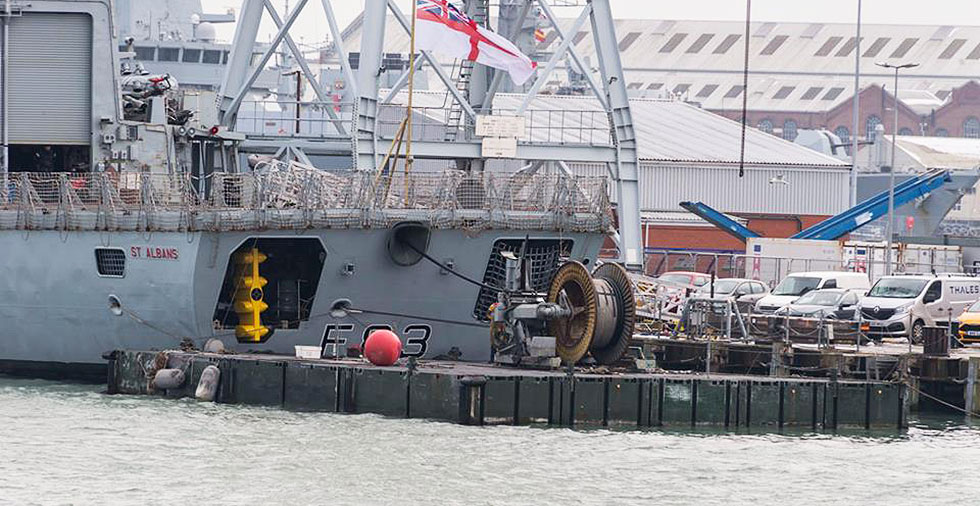
HMS St Albans 2087 passive towed array being reloaded from a drum on the barge. When in use, it is trailed out through the fairlead in the stern from the winch at the forward end of the quarterdeck. (Photo: S. Wenham)
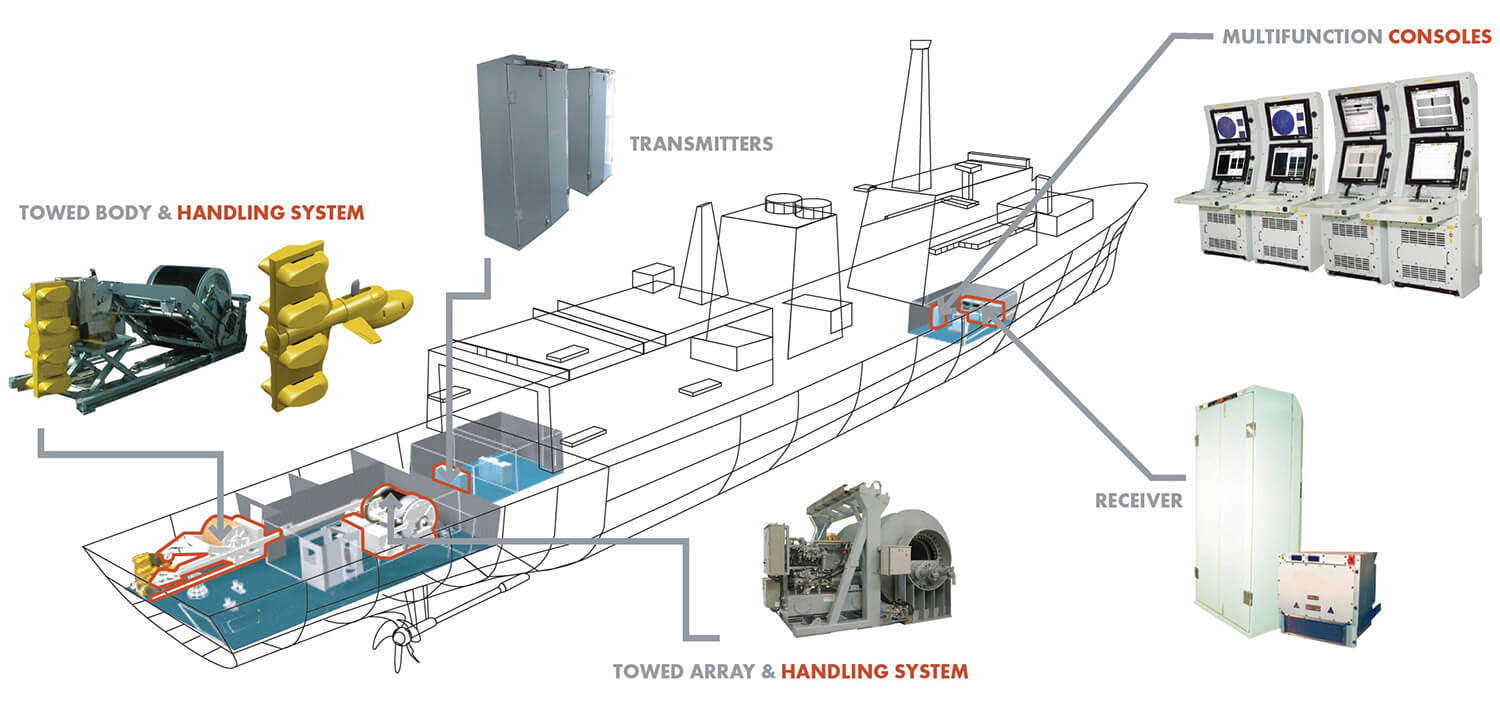
The Type 2087 sonar fit on the Type 23 frigate. The ‘wet end’ comprises the active yellow towed body and a passive towed array. (Based on original image from Thales)
Multi-Static Sonar Data Network Architecture (MSSDNA)
The establishment of a new network to share sonar data is a particularly good example of increasing effectiveness without the need to buy expensive new kit. The UK network will use standardised protocols for exchanging, storing and communicating sonar information but will be compatible with NATO and other allies systems. With a cohesive networked platform, the RN will be better able to leverage AI, big data tools, rapid algorithm and app development. Programme Nelson will coordinate the MSSDNA development and integration effort which should be completed by 2023.
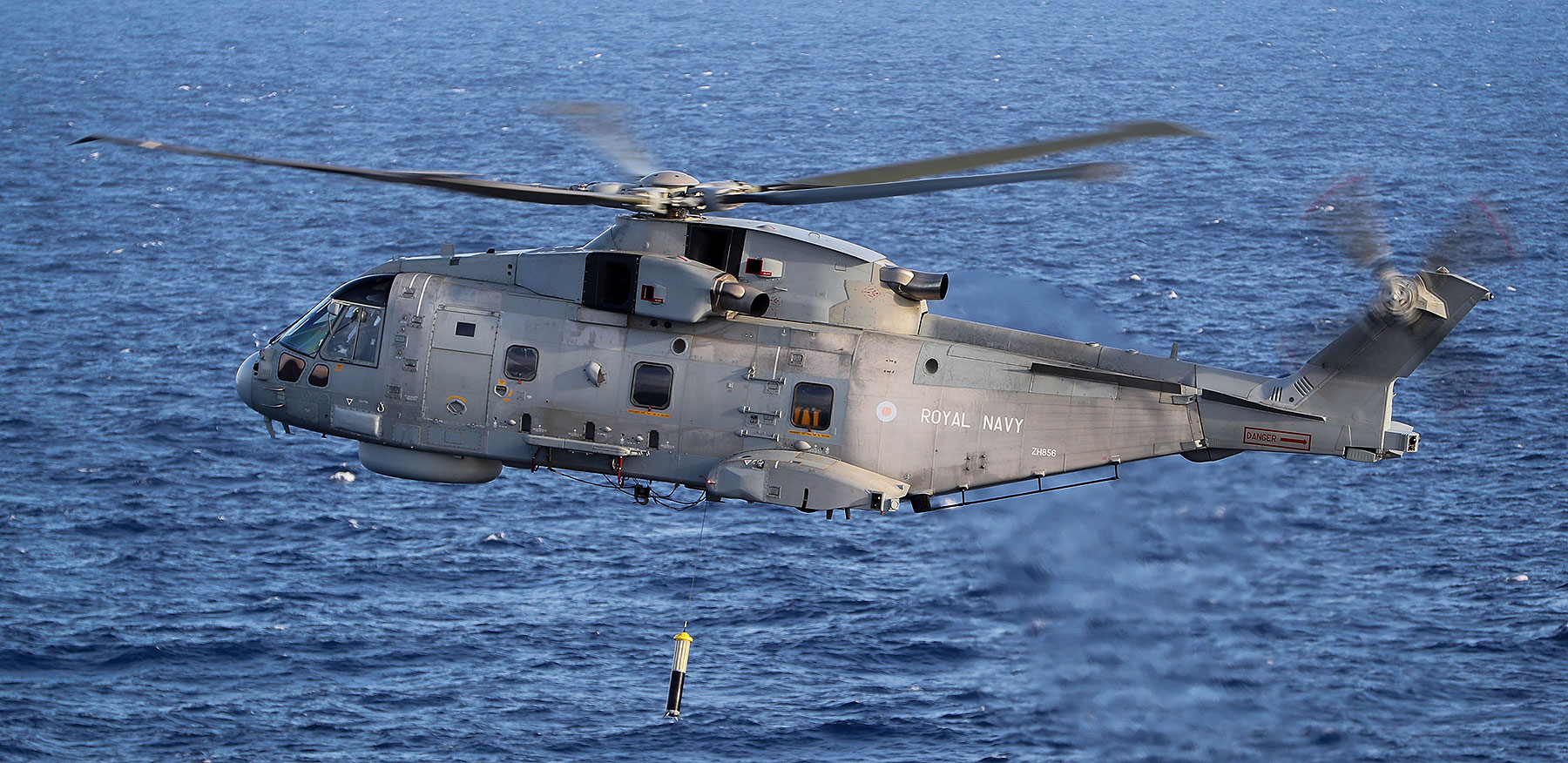
A Merlin Mk2 of 820 NAS, the specialist UK Carrier Strike Group ASW squadron, lowering the FLASH dipping sonar. MSSDNA will help share sonar data between the UKCSG assets extending the range of ASW coverage.
Advanced sonobuoys
ASW spearhead will continue the development of miniaturised sonobuoys designed to be dropped from small fixed or rotary-winged UAVs. Ultra Electronics has delivered more than 123,000 conventional sonobuoys to the Ministry of Defence in the last 15 years. (This provides something of an indicator of just how busy the RN is on ‘peacetime’ ASW exercises and missions monitoring foreign submarines.) These are critical expandable ASW sensors dropped by the Merlin (and soon by the Poseidon). Reduced size and weight could allow more to be carried by existing aircraft or enable a new method of ASW using UAVs to lay a field of MSA sonobuoys more cheaply than manned aircraft. Ultra Electronics is developing reduced size HIDAR (High Instantaneous Dynamic range Analysis and Recording) and Active Low-Frequency Electro-Acoustic (ALFEA) buoys which meet this requirement.
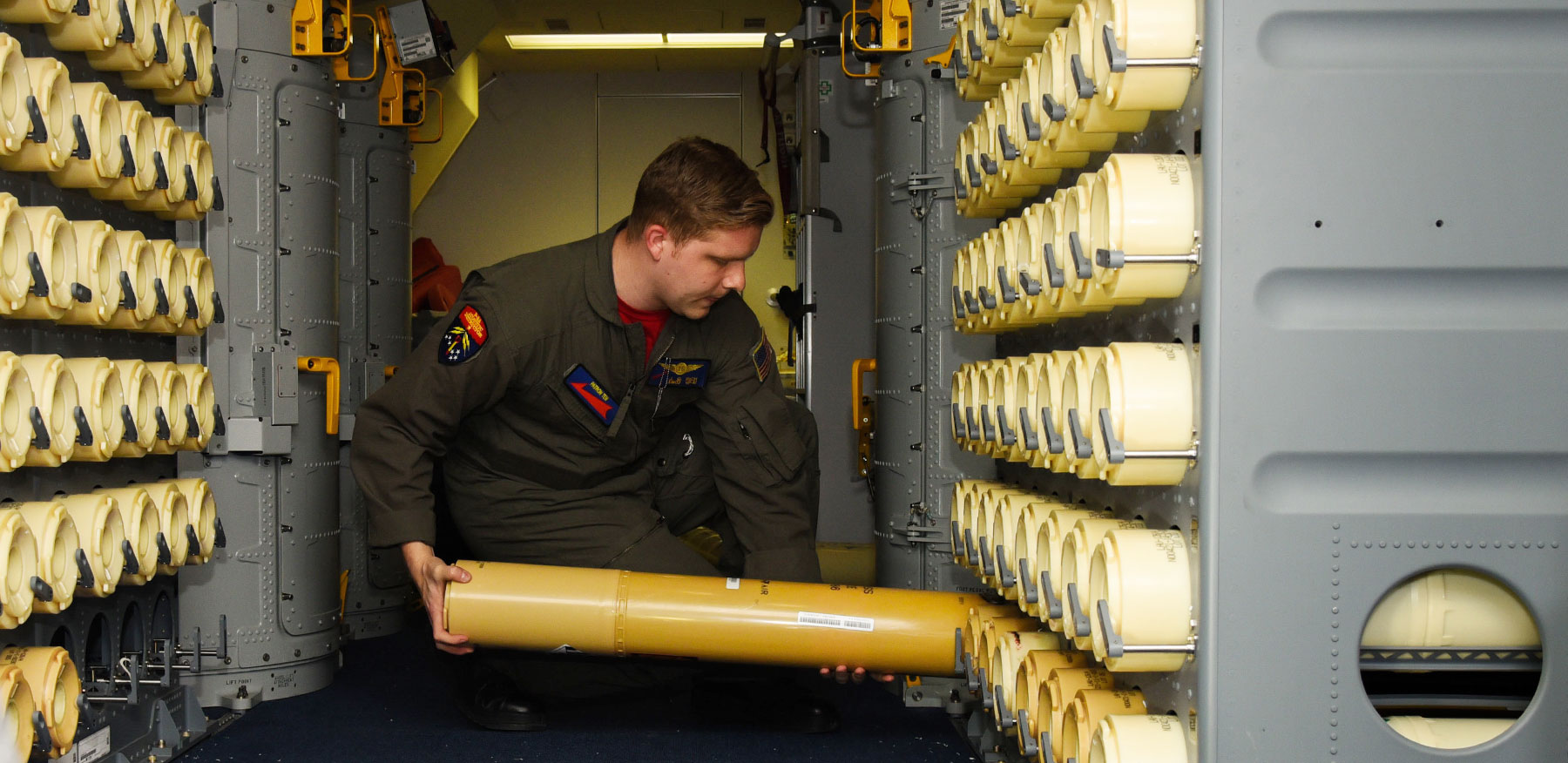
Loading sonobuoys into the storage racks onboard a US Navy Poseidon. The sonobuoys are dropped from the grey dispensers visible behind. The effect on the marine environment of thousands of expired sonobuoys containing large batteries that sink to the seabed is perhaps another good reason to pursue miniaturisation.
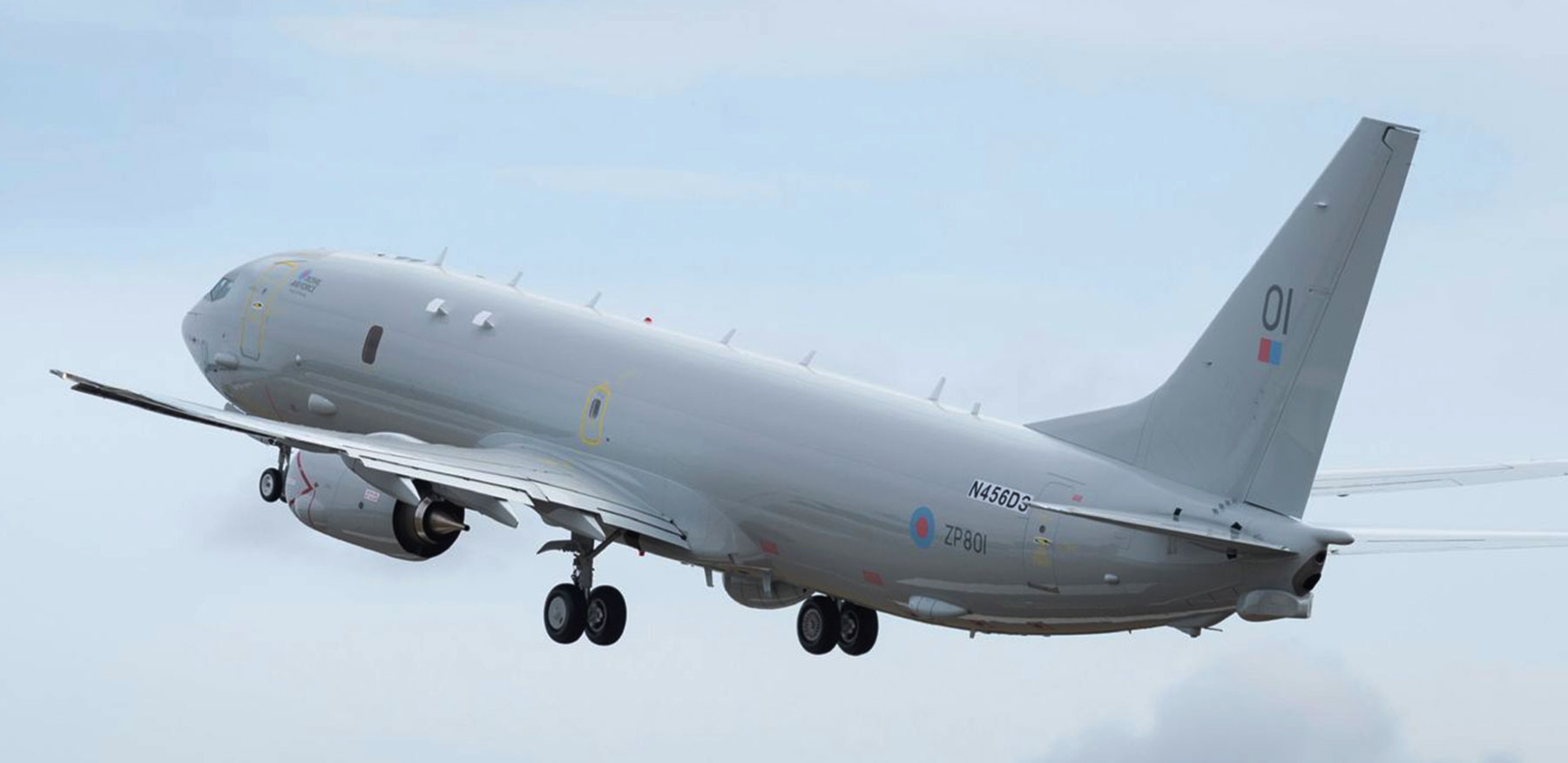
ZP801 ‘Pride of Moray’, the first UK owned Poseidon P-8A (to be called the MRA Mk1 in RAF service) takes off for first test flight from Boeing’s facility in Seattle. She will be delivered to the UK in February and begin flight operations from RAF Lossiemouth by the end of 2020. The 9 Poseidons are replacements for a fleet of Nimrod MR2s that once numbered 35 aircraft.
ASW decision support
Tools that help Captains and Warfare Officers make the best choices from the information available has long been the goal of naval combat management systems going back to the 1950s. A new generation of tools is needed to cope with increasing amounts of sensor data and to manage off-board Maritime Autonomous Systems (MAS). New analysis tools to reduce operator workload and speed ASW operations will be developed. Platform and sensor deposition will be enhanced based on live, historical and environmental data presented within a common user interface. Under a 7-year plan starting this year, the first onboard trial should be conducted within 18 months to compare available options.
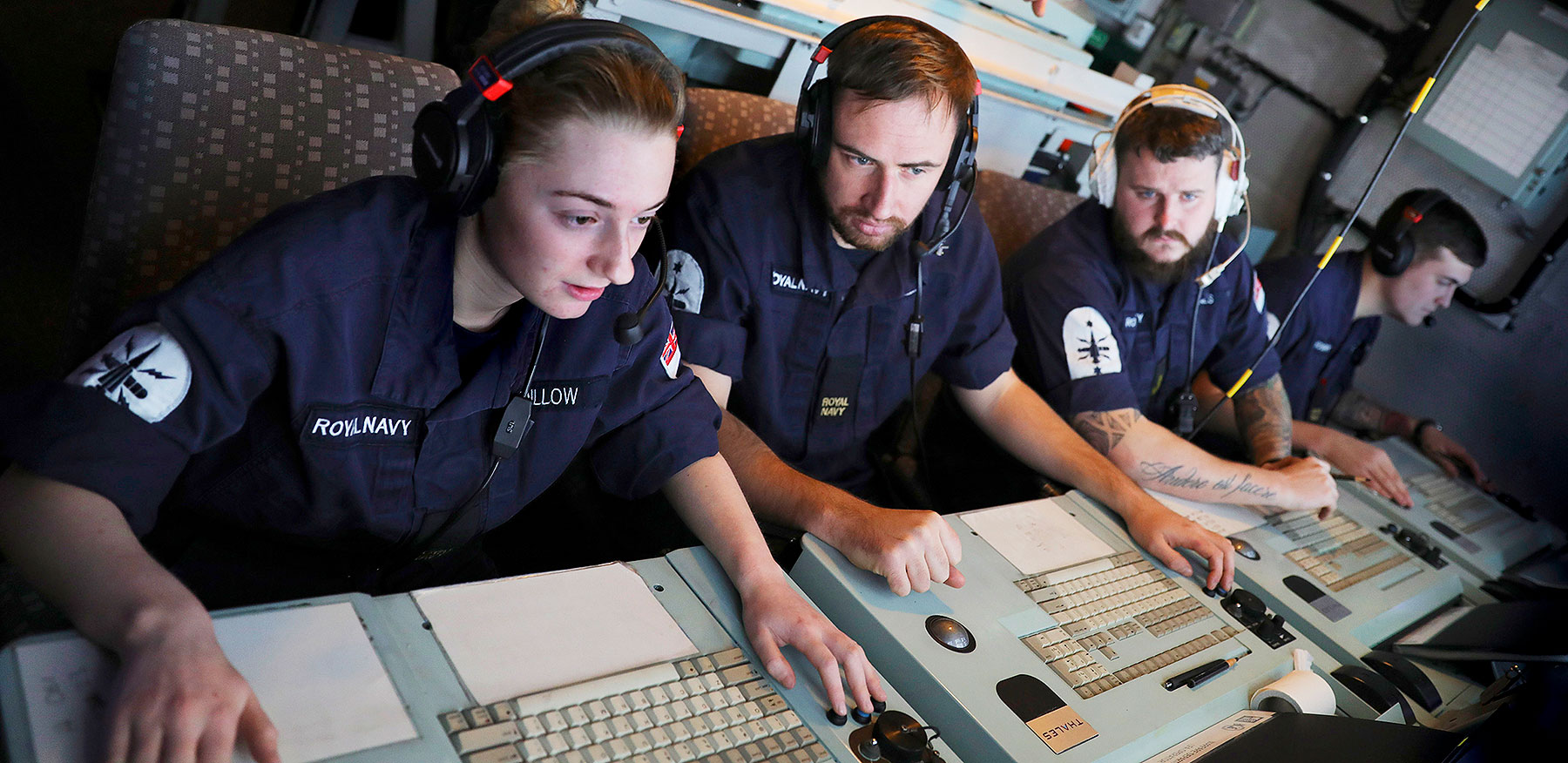
Sonar operators at work, HMS Northumberland November 2018, Exercise Trident Juncture.
Science and research
The MoD-owned Defence Science and Technology Laboratory (DSTL) will lead the research that will underpin the ASW Spearhead projects. Scientific expertise from within DSTL and academia will be used particularly to better understand the underwater environment and develop processing techniques for the enhanced sonars and MSA networks. DSTL will also develop the ‘Future Operations Room’ to provide new Command & Control (C2) systems for use in complex ASW scenarios. This will be done by exploiting emerging technologies, analysing information flow in the command teams, identifying work done by sailors which could be automated and experimentation with new operations room layouts. In close cooperation with Programme Nelson an initial series of development ‘sprints’ will focus on developing imagery for operators to visualise the underwater battlespace, new planning tools and real-time operations.
Anti-submarine warfare capability is often overlooked but is foundational to UK security. ASW Spearhead is evidence of a navy tying to stay on the front foot in this important contest, determined to innovate where it can and to catch up with rapidly advancing technology.
Copyright: Article and images, Save the Royal Navy

Comments on Royal Navy begins initiative to maintain its anti-submarine edge